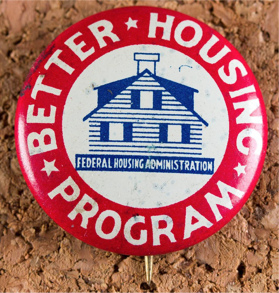Physical Address
304 North Cardinal St.
Dorchester Center, MA 02124
Physical Address
304 North Cardinal St.
Dorchester Center, MA 02124

Kevin Erdmann argues that mortgage credit standards are too tight. Others say the federal government is subsidizing homeownership. Can they both be right?

The benefit-cost ratio of housing supply subsidies looks terrible. And the state of research is even worse.

The government exercises tremendous power over residential design in the US. Its influence is nearly invisible, because it works through complex financing programs, insurance incentives, and secondary markets. These mechanisms go unnoticed, but their effect is hard to miss—they remade the United States into a nation of sprawling suburbs. This is the second post in a series about government policies that encouraged suburban growth in the US. You can find the first post here. What image springs to mind when you picture “federally subsidized housing”? Most people imagine a low-income public housing tower, a homeless shelter, or a shoddy apartment building. Nope—suburban homeowners are the single biggest recipient of housing subsidies. As a result, suburbs dominate housing in the United States. For decades, federal finance regulations incentivized single-family homes through three key mechanisms: Insurance, National mortgage markets, and New standards for debt structuring The housing market hides these details from the typical home buyer. As a result, most people are unaware of these subsidies. But their effects are striking—they determined the location and shape of development across America for generations. A New Deal to restore the housing industry Debt has a negative connotation these days. Credit cards, student loans, and auto loans are the anchors that keep many Americans in debt for most of their life. Meanwhile, we view mortgages very differently—they are seen as an investment, a symbol of adulthood, and a sign of financial stability. This was not always the case. In the early 1900s, mortgages were just like any other kind of debt. Nowadays payments are spread out over decades, but back then they came due all at once after a few years. Most people didn’t have enough cash at the end of the term. It was standard to pay back some and negotiate a new loan for […]

This is the first article of a five-part series on suburbia in the United States. In primary school, one of my friends lived in a duplex. This fact blew my mind. To my inexperienced 7-year-old mind, a duplex barely registered as a house. Her family shared a driveway with their neighbors, and their yard was tiny. It was the first house I’d ever seen that shared a wall with its neighbors. I’d seen apartments of course, but in my mind those were temporary, for people who who were saving up to buy a “real” home. I couldn’t understand that some people might actually prefer to live in something besides a private home, because I’d never come across it before. Median income in American cities tends to rise at about 8 percent per mile as one moves away from the business district. My mental model of the world was pretty typical for an American child brought up in a single-family home. It’s easy to see why—US residential development is dominated by suburbs, and home ownership is touted as the ultimate symbol of prosperity. Other types of dwellings tend to be for young people starting out in life or low income households unable to afford a place of their own. The popular image of the American Dream includes a white picket fence and a car, not an apartment and a subway pass. This is in stark contrast with most other countries. The French word for suburb is banlieue, and it has come to connote poverty and social isolation, because that is where immigrants and the poor tend to live. They’ve been known as “red suburbs” because of their tendency to vote Communist. Meanwhile, the wealthy live in the city center. In South Africa, the inner city is reserved for the privileged white […]
When comparing costs of various modes of transit, units measured “per passenger-mile” are very common. It makes sense intuitively – people take trips of varying length, and longer trips are more expensive than shorter trips, so the desire to standardize and compare makes us want to simply divide the trips by their length and call it even. Both supporters and opponents of light rail use per passenger-mile costs and subsidies to justify their positions, the government keeps tabs on them, and Randal O’Toole at the Cato Institute has even used carbon emissions per passenger-mile to claim that cars are more environmentally friendly than rail. The problem with measure at the rate of distance traveled is that the purpose of transit is not to travel long distances – these are not pleasure travelers trying to get as far from home as possible, but rather commuters trying to get to wherever their jobs and schools are located. But the distance to this “somewhere” is not a variable to be held constant – it actually varies with population and job density, which is highly correlated with mode of transit. Places with train lines generally have and allow for denser development and thus less distance between your house and your workplace or school – the difference in average commute distance between urban and exurban areas could be as much as an order of magnitude. Measuring costs in terms of total costs per person and not per passenger-mile makes intuitive sense when you think about it in terms of personal finances. If you lived in Brooklyn and your office moved from Manhattan to somewhere out in suburban Long Island and your transit expenses rose from $89/month for a Metrocard to $300/month for the cost of the car plus insurance, gas, and upkeep, it would be […]
At Streetsblog, Ryan Avent presented a scorching attack on the most notorious free-market impostor – Randal O’Toole: Taking Liberties With the Facts for his consistent hypocrisy: The Cato Institute’s Randal O’Toole gets under the skin of many of those interested in building a more rational and green metropolitan geography, but in many ways he’s an ideal opponent. It would be difficult to concoct more transparently foolish arguments than his. The man is an engine of self-parody. The requisite identification of “libertarian” contradictions: This is one thing I’ve never understood about the libertarian love affair with highways; they seem utterly blind to the fact that it has required and continues to require massive government action to build and maintain the road network. The interstate highway system is perhaps the single largest government intervention in the economy in the 20th century. Reading O’Toole you’d think it was a wonder of the free market. And with ease, Ryan points out the data needed to take O’Toole to task on his persistent assertion the “roads pay for themselves”: The source of his blindness on the issue seems to be due to his belief that roads pay for themselves, and that congestion exists only because governments shift gas tax revenue to pay for transit and other smart growth projects. Nothing could be farther from the truth. In the first place, gas tax revenue comes nowhere near paying for roads. Federal gasoline tax revenues cover barely half of the annual budget of the Federal Highway Administration. Add in diesel tax revenues and you’re still short. And that’s just the federal budget picture. In response, Randal replies to critics in the comments of his latest post of his “Antiplanner” blog: The Antiplanner sees the American dream as freedom of lifestyle choices and opportunities to realize those choices […]
This post is part of an ongoing series featured on Market Urbanism called Urbanism Legends. The Urbanism Legends series is intended to expose many of the myths about development and Urban Economics. (it’s a play on the term: “Urban Legends” in case you didn’t catch that) Last week President-elect Obama announced some details of his economic stimulus package: Second, we will create millions of jobs by making the single largest new investment in our national infrastructure since the creation of the federal highway system in the 1950s. We’ll invest your precious tax dollars in new and smarter ways This further taxpayer subsidization, beyond currently insufficient highway revenue sources, of sprawl and auto-dependency seems to contradict Obama’s promise of “green jobs”. As Tyler Cowen remarks, “for better or worse you can consider the opposite of a carbon tax.” Furthermore, the Obama plan intends to fund the stimulus directly to states, as opposed to metro areas, which have historically received almost two-thirds of the funds directly. Certainly, Obama’s plan is not an urbanism-friendly plan, yet I consistently hear urbanists subscribing to and spreading the myth that jobs can be created by spending on infrastructure, and that these jobs will lead to economic recovery. Even if the job creation myth were true, and could stimulate the economy immediately, you would think urbanists would not sacrifice urbanist ideals for the sake of short-term recovery through their commitment to so-called progressive ideology. In his enduring 1961 classic, Economics in One Lesson, Henry Hazlitt addresses the long-standing myth about “creating jobs” through public works projects: A bridge is built. If it is built to meet an insistent public demand, if it solves a traffic problem or a transportation problem otherwise insoluble, if, in short, it is even more necessary to the taxpayers collectively than the things for which […]